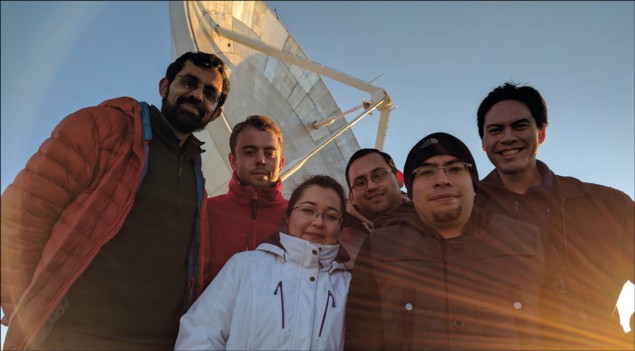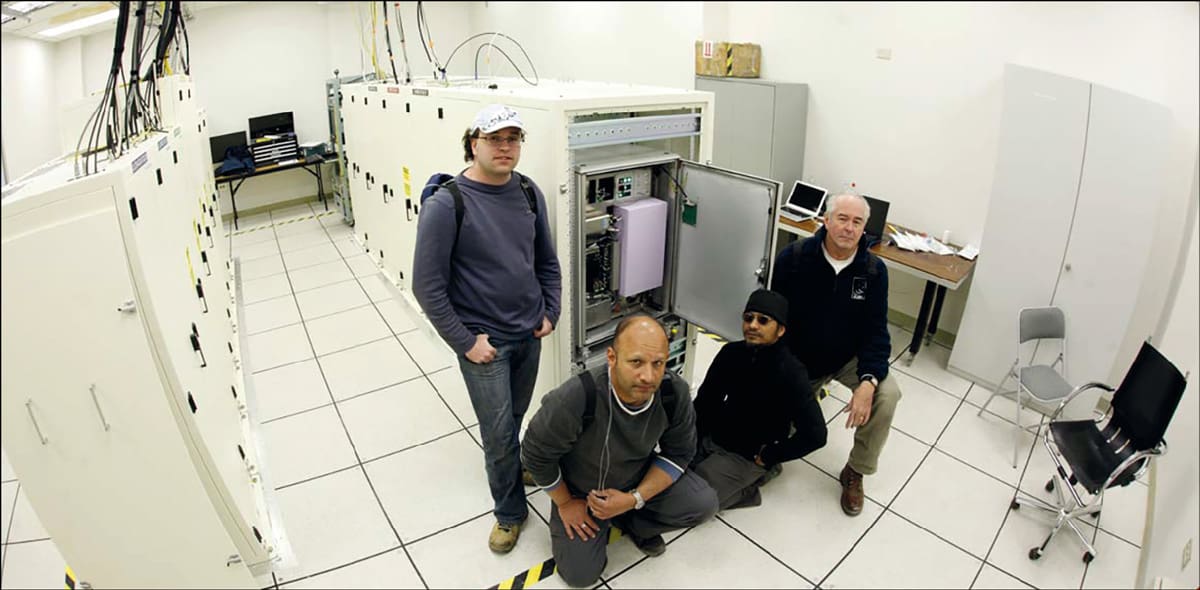Compiling the historic picture of the singularity at the centre of the M87 galaxy involved paying extremely close attention to equipment details, finds Andy Extance

At times, Gopal Narayanan admits, putting together the telescope that captured the first image of a black hole was an “organizational–logistical nightmare”. Narayanan is an astronomer working at Mexico’s Large Millimeter Telescope (LMT) Alfonso Serrano, which is one of eight ground-based radio observatories that make up the Event Horizon Telescope (EHT). Narayanan is therefore well-versed in the project’s complexities, from high-level discussions between collaborators down to the many layers of equipment that made the image possible. The fact that this group of 250 or so scientists and engineers pulled off such a tricky observation is, he says, “a testament to human ingenuity”.
That ingenuity comes into sharper focus when you consider how many different technologies had to work together before the black hole could come out of its shadow. The idea of bringing together existing radio telescopes operating at millimetre wavelengths originated in the mid 2000s, and rests on a concept known as Very Long Baseline Interferometry. The “very long baseline” part refers to the large distances separating the observatories: the EHT’s other telescopes are located in Hawaii, Arizona, Chile, Antarctica and Spain. The “interferometry” part is what enables the collaboration to decode detailed images from the radio signals that each telescope receives. The astronomers combine signals from the different telescopes, creating constructive interference from which meaningful signals emerge. In doing so, they create what Narayanan calls “the next best thing to an Earth-sized telescope”.
But it’s a strange kind of telescope. Each observatory is unique, and therefore faces highly individual challenges, like overcoming local conditions to point to the right place in the sky. Yet to become a successful interferometer, they also must strive to record data in harmony, meaning all must use similar maser clocks and digital electronics.
Interferometers seek to add together amplitudes of desired signals, explains Miguel Sánchez Portal, station manager of the EHT’s Spanish member, the Instituto de Radioastronomía Milimétrica (IRAM) in Granada. Within an interferometry network, each telescope’s receiver collects signals from radio waves, for example as voltages from the sensors in its receivers. Later, the continuous recorded signals go into a system that correlates the data from different observatories. EHT has two correlator centres, one at the Max Planck Institute for Radio Astronomy in Bonn, Germany, and one at the Massachusetts Institute of Technology’s Haystack Observatory near Boston, US. These correlators shift the observatories’ data sets until they add coherently, increasing the wave’s amplitude, Sánchez Portal explains.
Precision pointing
Before the signals can be added together with any confidence, each telescope needs to be able to point very precisely at whatever celestial target the collaboration wishes to observe. For the EHT’s largest telescopes, this is literally a tall order. When the LMT helped record the iconic image, its primary reflector surface was 32 m in diameter – half the height of the famous pyramids at Teotihuacán, a few hours’ drive away. The LMT also sits 4600 m above sea level, on a mountain, Sierra Negra, that is frequently exposed to buffeting winds. To make matters worse, changes in the amount of solar radiation hitting the LMT over the course of a normal day and night makes its supporting structure curl “almost like a potato chip”, Narayanan says.
To make the telescope both stiff and routinely able to return to the same position, LMT’s scientists and engineers must fight the elements. The telescope’s primary reflector is currently composed of 180 plates, all of which require micrometre-range adjustments. To accomplish this, each plate is mounted on a set of four electromechanical actuators that maintain the appropriate shape. A similar set-up exists at the heart of the telescope, in the smaller secondary mirror that collects light from the primary reflector and directs it onto the final receiver. This secondary mirror, or subreflector, is aligned by a “hexapod” system that can shift and twist it in all three spatial dimensions, explains Christoph Stiebel, an engineer at the Karlsruhe, Germany-headquartered company Physik Instrumente (PI), which has supplied hexapods to other EHT facilities.
Hexapods, Stiebel notes, are complex mechatronic systems, incorporating mechanics, motors, sensors and electronic control units. All of these components must work together to compensate for small shifts in position due to temperature changes and differences in mechanical load as the telescope’s orientation moves. In many telescope environments, that isn’t easy. The hexapods PI supplied for the Atacama Large Millimetre/Submillimetre Array’s (ALMA) and the Atacama Pathfinder Experiment (APEX) in Chile, for example, were custom designed to have especially rigid joints, to help achieve the high precision levels needed. Being in Chile also meant that the hexapods had to withstand earthquakes and being blasted with Atacama Desert sand. Worse still, the region’s low humidity raised the risk of electrostatic discharge. High altitudes bring unusual extra problems, like poor cooling conditions and cosmic radiation, Stiebel says, making electronics more likely to fail. “All these unusual environmental conditions led to unexpected failures and the need to develop new designs, which we did,” he adds.

Tuning in
Even with good adjustment and positioning technology, getting the telescope pointing and focusing correctly is a time-consuming task. At the LMT, Narayanan and his colleagues run calibration routines to ensure that their systems are working optimally. Typically, this involves observing well-known, bright, point-like astronomical bodies and feeding any inaccuracies into a complex mathematical model. For each hour of EHT data-gathering, Narayanan estimates that the LMT team spent 10 hours on calibration.
Then, to collect the signal from the subreflector, Narayanan and his colleagues at the University of Massachusetts built a concentrating system for the LMT involving metal waveguides and so-called “feedhorns”. From there, the signal goes to superconducting receiver mixers – the most sensitive way to down-convert radio signals available – that were built at the University of Virginia. To keep them below the temperature at which they become superconducting, these receivers sit inside cryostats at 4K, under vacuum.
The astrophysical phenomena around black holes emit radiation in the 227–230 GHz range. However, it’s impossible to record frequencies above 100 GHz directly onto digital computers. EHT receivers therefore employ a heterodyning approach. Narayanan describes heterodyning as similar to amplitude modulated (AM) radio, where audio signals are combined with a continuous sine wave “carrier” at a frequency of, say, 1400 MHz. Because the receiver “knows” that the incoming frequency is 1400 MHz, it removes the carrier, and the remaining audio is then sent into your loudspeakers, Narayanan explains.
At the LMT, heterodyning reduces the raw signal frequency to an easier-to-process 6–8 GHz range by subtracting the output of a local oscillator that provides a 221 GHz waveform. From there, the 6–8 GHz signal passes through a device called a block downconverter, which reduces the frequency still further. The lower frequencies make it easier to both transport and digitize the signal. Digitization is done using devices called ROACH2 Digital Back Ends (R2DBEs), which are made at Haystack, in Bonn, or at Radboud University in Nijmengen, the Netherlands. An R2DBE, Narayanan explains, takes the digitized data packets and sends them to the recorders. From there, the time-stamped data is “pretty much streamed directly into the hard drives” which are then physically shipped to the correlation centres for the data to be extracted.
Excellent timing
To ensure a successful correlation, the EHT collaboration sets standards for how observations are made across all its telescopes. In some cases, that has meant adjusting the facilities’ equipment. For example, the 30 m diameter dish telescope at IRAM had previously recorded light that was polarized along horizontal and vertical axes. EHT specifications, however, call for circular polarization, so the Granada telescope installed additional filters into its optical path. The correlation process also requires the data to be time-stamped to picosecond accuracy, which meant that the rubidium optical lattice clock that IRAM previously used wasn’t up to the job, says Sánchez Portal. Using a central timing device to synchronize observations remotely wasn’t an option either, since signal propagation delays would have limited accuracy to mere nanoseconds. Instead, IRAM and all the EHT observatories upgraded to hydrogen masers – at a cost of $250,000–500,000 each, according to Narayanan.
The masers provide both accurate timing and a frequency standard. “If you have the same signal at two antennae in different places on the Earth, you tag packets with a timer,” explains Sylvère Froidevaux, chief operating officer of Neuchâtel, Switzerland-headquartered T4Science. His company supplies the hydrogen maser clocks used at ALMA, which can tag events to precisions better than the nearest femtosecond.
While the hydrogen masers can be used directly for timing, their output must be boosted to higher frequency to serve as a reference standard. For example, the maser that LMT bought from California-headquartered Microsemi, produces just a 10 MHz frequency base, much too low for heterodyning with the 227–230 GHz black hole signals. From there, observatories use devices called synthesizers to multiply the reference signal, which might raise the frequency to 1 GHz, Sánchez Portal explains. From that intermediate step “several signal multipliers” provide the boost to provide the 221GHz local oscillator, he adds.
A ‘miraculous’ result
Every stage of setting up the EHT brought its own challenges, and Narayanan stresses that this is far from a complete list. Yet in the 2017 observing campaign that led to the image of the M87 galaxy’s black hole, all of these problems were, somehow, resolved – an outcome he calls “miraculous”. “All sites had various different issues and technical glitches ahead of the campaign,” he recalls. “We all seriously worked together and solved all the problems. Then the weather was sweet, the whole seven days. At the end of that run I remember thinking ‘This must be it.’ ”
In months since that first run, LMT, IRAM and the other EHT observatories have steadily been upgrading their capabilities, Narayanan and Sánchez Portal note. With the collaboration now working on 2018’s data, the picture unveiled in 2019 was just a taster. And as astronomers gradually improve their planet-sized telescope they will continue to draw us in with detailed pictures of the hypnotic beauty of black holes.



